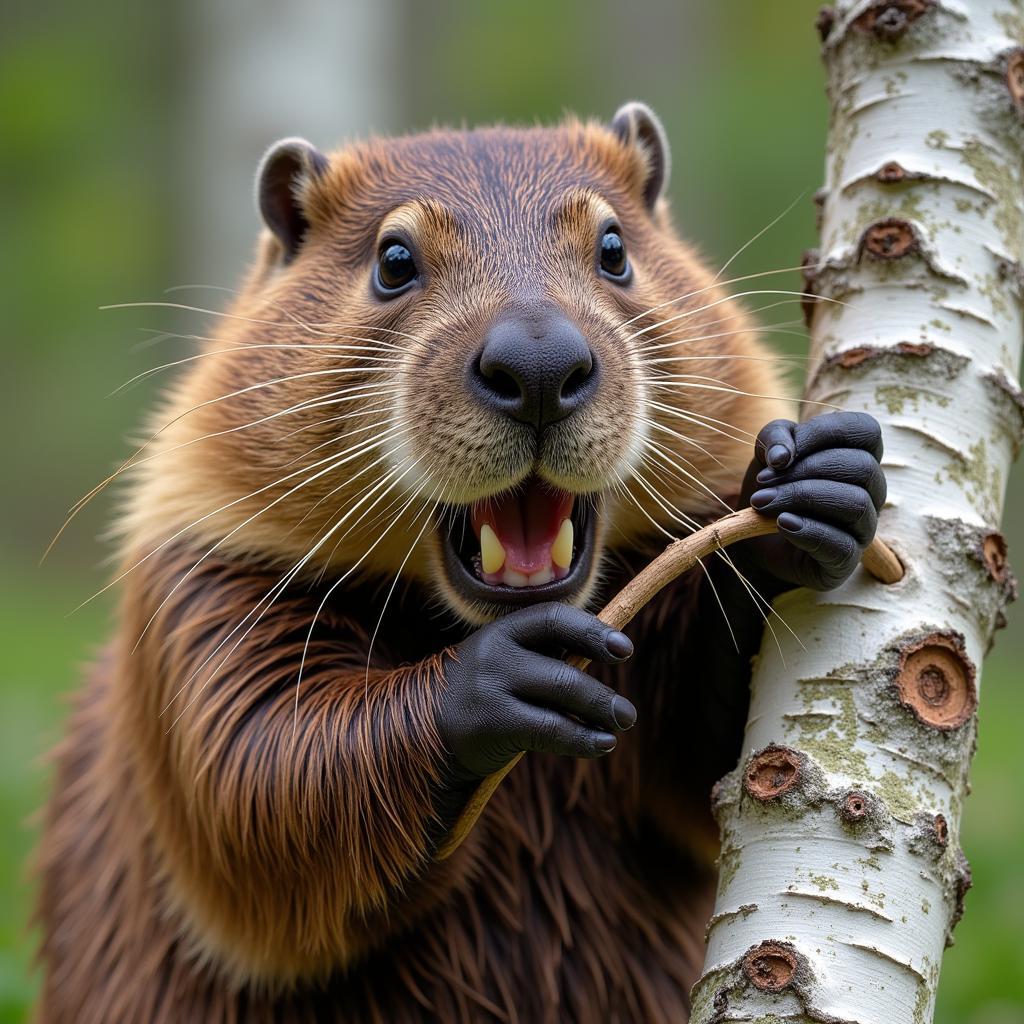The Beaver Food Chain is a fascinating example of how a single species can dramatically shape its environment. Within the first few sentences, we delve into the intricate world of these remarkable ecosystem engineers and their role in the food web. From their preferred diet to their predators, understanding the beaver’s place in the food chain unveils a complex tapestry of life.
The Beaver’s Vegetarian Feast: What Do Beavers Eat?
Beavers are strictly herbivores, meaning their diet consists entirely of plants. They have a particular fondness for aspen, willow, and birch trees, often felling these to access the nutritious inner bark, twigs, and leaves.  Beaver eating bark from an aspen tree They also consume a variety of aquatic plants, including water lilies and pondweed, adding diversity to their vegetarian menu. This selective feeding behavior has a profound impact on the surrounding ecosystem, creating habitats for other species.
Beaver eating bark from an aspen tree They also consume a variety of aquatic plants, including water lilies and pondweed, adding diversity to their vegetarian menu. This selective feeding behavior has a profound impact on the surrounding ecosystem, creating habitats for other species.
Predators of the Beaver: Who’s Hunting?
Despite their impressive size and dam-building skills, beavers are vulnerable to a number of predators. food chain beaver Large carnivores like wolves, coyotes, and bears pose a significant threat, especially to young beavers or those venturing away from the relative safety of their lodge and pond. Bobcats and lynxes are also known to prey on beavers. In aquatic environments, larger fish like pike and otters may target beaver kits. Even birds of prey, such as eagles, can snatch up young beavers. This delicate balance within the beaver food chain highlights the constant struggle for survival in the wild.
The Beaver’s Role as a Keystone Species
Beavers are considered a keystone species because their presence has a disproportionately large impact on their environment. By building dams, they create wetlands that provide habitat for a wide range of species, from fish and amphibians to birds and mammals. These dams also help to regulate water flow, reduce erosion, and improve water quality. The flooded areas created by beaver dams provide ideal breeding grounds for insects, which in turn become food for other animals. This ripple effect demonstrates the beaver’s vital role in maintaining the health and biodiversity of their ecosystem.
How Human Activities Impact the Beaver Food Chain
Human activities, such as habitat destruction, pollution, and trapping, can have a negative impact on the beaver food chain. Loss of suitable habitat due to deforestation and development limits the beavers’ ability to build dams and find food. eagle fish food] Pollution from agricultural runoff and industrial discharge can contaminate waterways, impacting the health of beavers and their food sources. Understanding and mitigating these impacts is crucial for preserving the beaver and the intricate web of life they support.
“Beavers are truly remarkable creatures,” says Dr. Emily Carter, a leading wildlife biologist. “Their impact on the landscape is unparalleled, and their role in the food web is essential for maintaining healthy ecosystems.”
Conclusion: The Beaver’s Crucial Role
The beaver food chain is a complex and fascinating system that demonstrates the interconnectedness of life in the wild. From their herbivorous diet to their role as prey for larger predators, beavers play a vital role in shaping their environment. Protecting these keystone species and their habitats is crucial for maintaining the health and biodiversity of our planet. The beaver food chain deserves our attention and respect.
“Protecting beavers is about more than just saving a single species,” adds Dr. Carter. “It’s about protecting the entire ecosystem they support.”
FAQ
- What is the beaver’s main food source? * Primarily trees like aspen, willow, and birch, along with various aquatic plants.
- What are the main predators of beavers? * Wolves, coyotes, bears, bobcats, lynxes, and sometimes larger fish and birds of prey.
- Why are beavers considered a keystone species? * Their dam-building activities create wetlands that support a diverse range of other species.
- How do human activities impact the beaver food chain? * Habitat destruction, pollution, and trapping negatively affect beaver populations and their ecosystem.
- What can be done to protect beavers and their habitat? * Implementing conservation measures such as habitat restoration, pollution control, and regulated trapping can help protect beavers and their vital role in the ecosystem.
- Are beavers endangered? * While not globally endangered, some local populations face threats and require conservation efforts.
- How do beavers impact water quality? * Their dams help filter pollutants and sediment, improving water quality downstream.
More questions?
Check out our other articles on related topics:
Need assistance? Contact us at Phone Number: 02437655121, Email: minacones@gmail.com or visit us at 3PGH+8R9, ĐT70A, thôn Trung, Bắc Từ Liêm, Hà Nội, Việt Nam. We have a 24/7 customer service team.